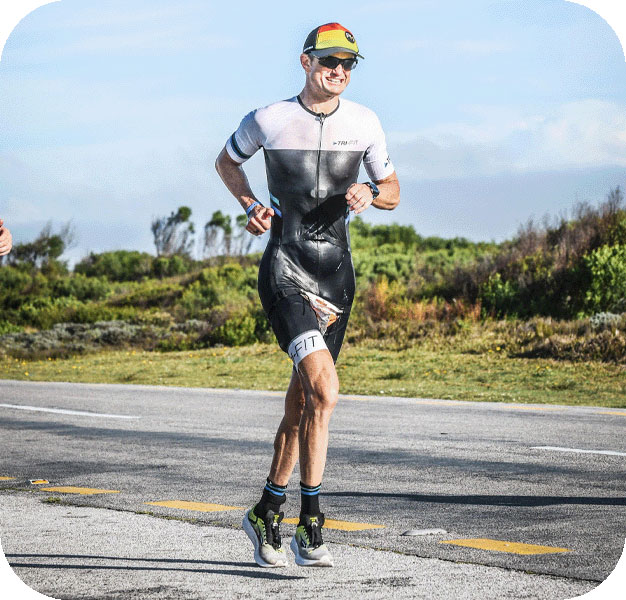Service by appointment only
Call 020 7736 0046
Call 020 7736 0046 To book

New year – new goals! For many of us, the chimes of Big Ben go hand-in-hand with setting targets for the twelve months ahead. For beginner runners, this might be achieving a landmark distance, while more seasoned athletes might be looking to achieve a specific, quicker time.

But how do we make sure we’re setting ourselves up for success over disappointment?
Andy Brodziak, Profeet’s longest-serving ambassador, is an endurance coach with 15+ years experience and Ironman athlete. Here he shares his top tips for a successful 2024.
Setting running goals – advice for beginners
So you’ve run your local parkrun, maybe a 10k and now want to train for a marathon or half marathon.
The key rule is to build consistency first, for six to eight weeks,” says Andy.
“For example, running two to three times a week, even if that’s just 20 minutes per run, is consistent. But if you’re someone who runs on a Saturday, then doesn’t run for 10 days and then runs four times in a row, that’s inconsistent.”
Once you’ve built consistency, the next rule is to gradually increase your running volume. Don’t add any more than 10% to your weekly volume. So if you’ve run 60 minutes in one week, don’t run for any more than 66 minutes the following week. And if you feel like you want to do more, do something on an indoor bike, cross training or some more strength work to complement your running.
With consistency established and a gradual training increase underway, it’s time to write down your goal. This has to be short term and specific – an event or a target distance you want to achieve in three months’ time – and not something vague such as ‘sometime this year, I want to run a marathon”.
However, a note of caution,
If you haven’t run for a long time or are coming back from a setback, please be patient and start by doing a walk run plan for 4- 6 weeks to gradually load the muscles and tendons. That would be 3min easy jog/1min walk x 4-6 and have a day off between.”
Setting running goals – for intermediate runners
You’ve run a few 10km races and maybe one or two half marathons, and you’re thinking of a marathon or an ultra. Andy advises:
You’ve got training consistency on your side already, so some structured training would benefit you most. Reverse engineering your training by working backwards from your goal target is a really focused way to be. … be realistic! If you want to run a three-hour marathon but have never run quicker than 3:30, that might be a bit unrealistic.
But let’s say you want to run the London Marathon on 21 April in four hours. Work out how many training weeks you’ve got until race day and have a look at your current 5km or 10km race times – using those you’ll be able to work out what paces you have to hit for your steady runs, tempo runs, and fast vO2 efforts. That’ll give you a rough idea of what your training balance will look like – but only if you have a realistic end goal.
Andy believes intermediate runners would also benefit from strength training.
We start losing muscle mass from the age of 40, so strength training is vital to injury prevention and hormone balance. We’re talking about regular load-bearing strength training as opposed to bench pressing heavy weights here – and this gets even more important as we get older, so – again – consistency is key”.
Setting running goals – advanced runners
Runners hoping for a faster finish or an even more challenging distance would benefit from a scientific approach to their training. Andy says:
A vO2 max lab test in a university would give advanced runners professional-level insight into their fitness. Meanwhile, Precision Hydration sweat testing looks at the sodium concentration in your sweat and can help build an in-race hydration strategy that’s unique to you. To find out more about Precision Hydration and to book a sweat test, visit Andy’s website.
Variety isn’t just the spice of life – it’s a vital training ingredient too. Explains Andy
The human body is actually quite lazy. The body will find a path of least resistance, so if you get used to climbing a mountain to take 10L of water up to the family every day, that becomes really easy and normal. But as soon as you start walking quicker, doing it in a different position or something up that mountain, you’ve stimulated something different. The body loves variety and that will re-stimulate growth.”
Coping with setbacks to your 2024 running goals
Whether you’re a beginner, intermediate or advanced runner, injuries can happen. Andy says a process of elimination can help root out the cause of those nasty niggles.
Ask yourself – ‘What have I changed?’ ‘Have I ramped up my volume too quickly?’ ‘Am I adequately hydrating?’ ‘Can I eliminate footwear?’. If the answer to the last question is ‘no’ then now’s the time for a visit to Profeet for an expert analysis of your running motion.
You want a body that ultimately is strong and in the right footwear”, Andy advises.
“Preventing injuries in the first place is far better than cure. Ask yourself – ‘am I actively recovering as well as I could?’ That means using a foam roller, getting a massage and taking days off. Strength training is key to injury prevention – pilates and yoga can really help.
And if an injury keeps coming back?
Then it’s worth getting a movement screening with a qualified physio or strength and conditioning coach”, Andy advises.
“We shouldn’t be a runner and then naturally always be injured. Those two things needn’t go hand in hand”.
Give yourself the best chance of reaching your goals this year, call 020 7736 0046. Book your one-to-one appointment with one of our qualified Profeet technicians.
OUR SERVICE IS BY APPOINTMENT ONLY
Profeet’s services are by appointment only, please call or book online in advance
